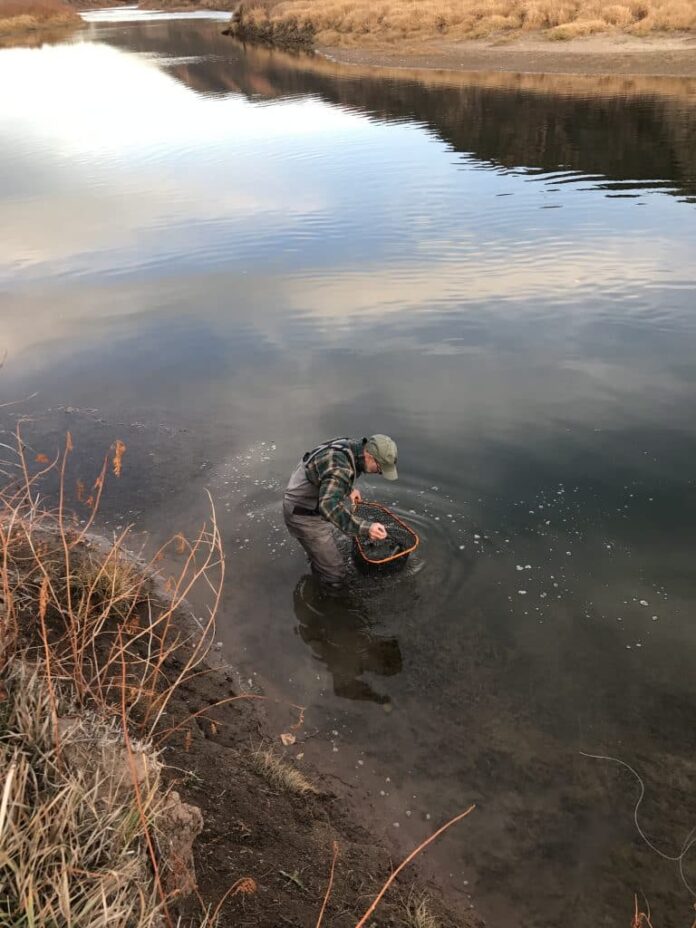Michael Salomone/Courtesy photo
Anglers conditioned to rising before dawn have felt the extremes in our local temperatures lately. The cold crept into our starlit hours and chilled the nighttime air. It takes the warmth of the sun to elevate the mercury again. How do anglers cope with the autumn weather and the inevitable 30-degree swing?
Anglers observe a massive swing in daytime temperatures while standing in the river. It can happen fast and without notice. Planning to be ahead of the game sets anglers up to address the issue accordingly.
At sunrise the air temperatures revolve around the freezing mark depending on where in the Eagle River valley the thermometer is placed. A typical Colorado sun-drenched day will experience a 30-degree increase in temperature or more. Closer observation tells anglers that the majority of the increase happens in half a day, peaking before the noon bell rings. The increase is more rapid than you think.
The fish don’t feel the adverse effects of cold night air all that much. It’s the bugs that don’t like the cold. If the food isn’t up and moving, the trout have little reason to get up and dance either. Once the sun works her magic upon the river water then things begin to wake up.

Michael Salomone/Courtesy photo
By mid-morning, the air temperature is rising. The water temperature doesn’t increase as much during the daily cycle but it does have an effect on the food. The water temperature could increase by as much as 10 degrees. While not all that much of a negative condition and still in a favorable range for happy trout, the nymphs feel the chill and slow down.

Support Local Journalism
Sunshine brings about activity, increasing insect emergence and spurring along the hatch. Knowing the sun will bring about the increase in bug activity allows anglers to be ready to surf the rise, capitalizing on the feeding activity.
Midges are very prevalent in the Eagle River. A significant number of Blue Wing Olive nymphs exist as well. When the sun blasts the temperature gauge toward the tree-tops, the nymphs begin to fill the water column quickly.
Anglers should respond accordingly. The first 90 minutes to two hours of light lets fly fishers nymph fish slow, deep water. This catches the fish ready to eat and eager to target the earliest stage of the insects. Use zebra midges and small pheasant tail nymphs for a common sense selection of flies.
By midmorning the air temperature is moving on up and the water temperature has collected enough warmth to spur along an emergence of insects. Midges are getting active, swimming upward. Top secret nymphs and others mimic the vulnerable emerging stage.

Michael Salomone/Courtesy photo
Small mayflies are emerging unnoticed by anglers but followed by trout. Nymph flies benefit from slight movement during the emergence but not an overly active swimming movement. The motion should be subtle to sell it properly. Soft hackles do just that; they breathe with life and sell it. A soft hackle pheasant tail in an appropriate size does the trick.
Before the heavy sun of midday begins its arc towards the horizon, adult bugs are prevalent and drawing strikes. Anglers anticipating the dry-fly action capitalize on early feeding by tying on dry flies at the first signs of surface feeding activity.
Knowing the trout will be following the most prevalent food source keeps the intelligent angler ahead of the game and in the action. Unlike the summertime, with multiple insects emerging simultaneously, the number of insects available are dwindling.
This can be good or bad depending on how you look at your cup — half-full or half-empty. One thing is, the insects are pretty easy to identify. Second, the fish could be ultra selective, giving anglers fits as they watch fish feed on midges while they continue to fish their size 18 zebra midge unsuccessfully — because it should be a 22.
Maintain a keen sense of awareness while wade fishing. Trout are moving into the shallows, searching for the food that is growing active in the warmth. A trout does possess a wonderful sense of camouflage but they can’t hide a shadow. With the low water conditions, sight fishing is part of the game.
Watch the thermometer. It is driving the activity. Stay ahead of the game, knowing where and what is driving the food. Looking ahead to next week and we might be talking about how to keep ice off your line guides.

Michael Salomone/Courtesy photo





























